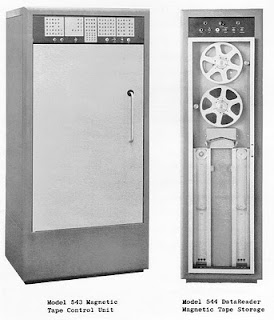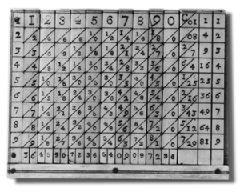 |
| A 15th century printing press similar to the one Gutenberg invented |
Punched Card (1750)
Punched cards or "Hollerith cards" were made of stiff board, the punch card represents information by the presence or absence of holes in predefined positions on the card. They were widely used throughout 19th and 20th century for controlling textile looms and operating fairground organs and related instruments.
Semen Korsakov was reputedly the first who used the punched cards in informatics for information store and search (1832).
Later in 1890 Herman Hollerith invented the recording of data on a medium that could then be read by a machine. Hollerith founded Tabulating Machine Company (1896), later renamed IBM. IBM developed punched card technology into a powerful tool for business data-processing and produce an extensive line of general purpose unit record machines.
 |
| Jacquard Punch Card Loom. Photo by George P. Landow. |
 |
| Original Hollerith punch card |
 |
| Above left: Punched card reader. Above right: Punched card writer. |
Punched tape (1845)
Long strip of paper in which holes are punched to store data. The earliest forms of punched tape come from looms and embroidery. Punched tape was widely used for teleprinter communication, and later as a storage medium for minicomputers and CNC machine tools.
Paper tapes were still in use in the 1970s through the early 1980s to transfer binary data for incorporation in either mask-programmable read-only memory (ROM) chips or their erasable counterparts - EPROMs.
 |
| Computer read instructions from punched paper tape at UNIVAC plant in Utica New York |
 |
| Manual code tape machine |
Magnetic tape (1928)
Developed in Germany in 1928. Made of a thin magnetic coating on a long, narrow strip of plastic.
First data were recorded in 1951 on the Mauchly - Eckert UNIVAC 1. The recording medium was a 1/2 inch wide thin band of nickel-plated bronze.
 |
| Add caption |
 |
| Above left: Magnetic tape control unit. Above right: Data reader. |
Magnetic drum (1932)
Drum was an early form of computer memory that was widely used in 1950s and 1960s. It was invented by Gustav Tauschek in 1932 in Austria. For many machines (ex. UNIVAC 1), a drum formed the main working memory. The capacity of a drum of 20cm long and 10cm in diameter was about 500.000 bit. Drums were later replaced by core memory, which was faster, with no moving parts.
 |
| Magnetic drum storage unit (UNIVAC 1 ) |
 |
| IBM 650 Magnetic Drum |
Selectron Tube
Early form of digital computer memory developed by Jan A. Rajchman in 1946, memory storage device proved expensive and suffered from production problems. Selectron tube had capacity of 256 to 4096 bits.
 |
| Selectron tube |
Hard Disk
A hard disk drive uses rigid rotating platters. It stores and retrieves digital data from a planer magnetic surface. The first HDD was the IBM Model 350 Disk File that came with the IBM 350 RAMAC computer in 1956. The total storage capacity was 5 million characters (just under 5MB) and weighted more then 200kg.
 |
| IBM hard disk drive fork lifted onto the plane, 1956 |
 |
| Foreground, two IBM 350 Disk Storage Units in operation |
Music tape
The compact audio cassette audio storage medium was introduced by Philips in 1963.
 |
| Audio compact cassette |
DRAM
Dynamic random access memory is a type of random access memory that stores each single bit of information in a separate capacitor within an integrated circuit. Using one-transistor cells paved the way for the worldwide explosion of the computing.
Invented in 1966 by Dr. Robert Dennard.
 |
| DRAM |
Twistor memory (1968)
Twistor memory was developed at Bell Labs and it used the same concept as the core memory. Twistor memory was formed by wrapping or closing magnetic tape arround current-carrying wire. Twistor was used only a brief time between 1968 and 1970. In this period all previous forms of memory were replaced by RAM chips.
Bubble memory (1970)
Bubble memory uses a thin film of a magnetic material to hold small magnetized areas, known as bubbles, each of which stores one bit of data. Bubble memory started out as a promising technology, but failed commercially as hard disk prices fell rapidly in 1980s.
8" floppy disk
In 1971 IBM introduced a data storage device composed of a circular piece of thin, flexible, magnetic storage medium encased in a square plastic wallet . The capacity of 8-inch floppy disk was about 100K bytes (100,000 characters).
5,25" floppy disk
In 1976, Alan Slugart developed a new smaller version of the 8" floppy disk. The main reason for this development was that the normal version (8-inch floppy disk) was too large for desktop computers.
In 1978 a double-sided drive for reading 5.25" floppy disk was introduced. So the storage capacity was increased from 100K bytes to 360K bytes.
1976
Apple's external floppy disk drive (5,25").
VHS
The Video Home System is a consumer - level video standard developed by Japanese company JVC and introduced in 1976.
CD
First compact disk was introduced by Sony in September 1976. But the idea to use light for recording and replaying music was few years older.
Standard compact discs have a diameter of 120mm, though 80mm versions exist in circular and "business-card" forms.
The first CD player was called Sony CDP-101 and was presented on the 1st of October 1982. The price was 625 US dollar.
3,5" Floppy disk
In 1981, Sony introduced the first 3,5" floppy drives and diskettes. These floppies were encased in hard plastic. They stored 400Kb of data, and later 720Kb (double-density) and 1.44Mb (high-density).
Floppy disk were in use more than 20 years. In 2003, Dell stopped including floppy drivers on their standard home computers. By 2007 PC world had also stopped selling the disks. And Sony is shutting down Japanese floppy disk sales by March 2011.
Twistor memory was developed at Bell Labs and it used the same concept as the core memory. Twistor memory was formed by wrapping or closing magnetic tape arround current-carrying wire. Twistor was used only a brief time between 1968 and 1970. In this period all previous forms of memory were replaced by RAM chips.
Bubble memory (1970)
Bubble memory uses a thin film of a magnetic material to hold small magnetized areas, known as bubbles, each of which stores one bit of data. Bubble memory started out as a promising technology, but failed commercially as hard disk prices fell rapidly in 1980s.
 |
| Buble memory developed by Andrew Bobeck |
8" floppy disk
In 1971 IBM introduced a data storage device composed of a circular piece of thin, flexible, magnetic storage medium encased in a square plastic wallet . The capacity of 8-inch floppy disk was about 100K bytes (100,000 characters).
 |
| 8-inch floppy disk |
5,25" floppy disk
In 1976, Alan Slugart developed a new smaller version of the 8" floppy disk. The main reason for this development was that the normal version (8-inch floppy disk) was too large for desktop computers.
In 1978 a double-sided drive for reading 5.25" floppy disk was introduced. So the storage capacity was increased from 100K bytes to 360K bytes.
1976
Apple's external floppy disk drive (5,25").
 |
| Apple A9M0110 PC 5.25 Floppy Drive |
VHS
The Video Home System is a consumer - level video standard developed by Japanese company JVC and introduced in 1976.
CD
First compact disk was introduced by Sony in September 1976. But the idea to use light for recording and replaying music was few years older.
Standard compact discs have a diameter of 120mm, though 80mm versions exist in circular and "business-card" forms.
The first CD player was called Sony CDP-101 and was presented on the 1st of October 1982. The price was 625 US dollar.
 |
| Diagram of CD layers |
 |
| First CD player Sony CDP-101 |
3,5" Floppy disk
In 1981, Sony introduced the first 3,5" floppy drives and diskettes. These floppies were encased in hard plastic. They stored 400Kb of data, and later 720Kb (double-density) and 1.44Mb (high-density).
Floppy disk were in use more than 20 years. In 2003, Dell stopped including floppy drivers on their standard home computers. By 2007 PC world had also stopped selling the disks. And Sony is shutting down Japanese floppy disk sales by March 2011.
 |
| 8", 5,25", 3,5" floppy disks. |
 |
| 8", 5,25", 3,5" floppy drives |

























